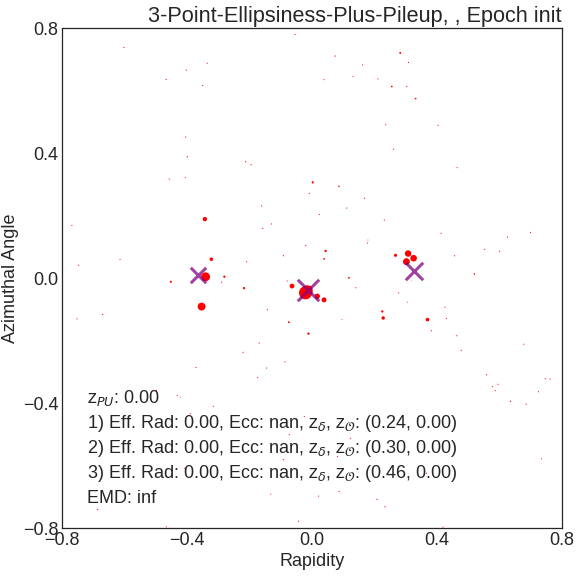framework for defining, building, and evaluating generalized shape observables for collider physics
Project description
SHAPER (v1.2.0)
SHAPER is a framework for defining, building, and evaluating generalized shape observables for collider physics, as defined in "SHAPER: Can You Hear the Shape of a Jet?" (arxiv:2302.12266). This package can be used for evaluating an extremely large class of IRC-safe observables, with modules in place to define custom observables and jet algorithms using an intuitive geometric language.
Pictured: Example of a custom jet algorithm, "3-(Ellipse+Point)iness+Pileup", as evaluated on an example top jet, as the SHAPER algorithm computes the value of the observable and optimal parameters.
The SHAPER framework contains::
- Pre-built observables, including N-subjettiness and isotropy.
- Novel pre-built observables and jet algorithms for finding ring, disk, or ellipse-like jets, with optional centers for collinear radiation and optional pileup radiation
- Modules for defining arbitrary shape observables using parameterized manifolds, and building new complex observables from old ones.
- Modules for evaluating defined shape observables on event data, using the Sinkhorn divergence approximation of the Wasserstein metric. This returns both the shape value ("shapiness") and the optimal shape parameters.
- Modules for visualizing shape observables and their optimization, as in the GIF above.
Installation
From PyPI
In your Python environment run
python -m pip install pyshaper
# python -m pip install --upgrade 'pyshaper[all]' # for all extras
From this repository locally
In your Python environment from the top level of this repository run
python -m pip install .
# python -m pip install --upgrade '.[all]' # for all extras
From GitHub
In your Python environment run
python -m pip install "pyshaper @ git+https://github.com/rikab/shaper.git"
# python -m pip install --upgrade "pyshaper[all] @ git+https://github.com/rikab/shaper.git" # for all extras
Example Usage
For an example of how to use SHAPER, see the notebook examples/example.ipynb. This notebook contains example code for loading data, using pre-built shape observables, defining custom shape observables, running the SHAPER algorithm to evaluate these observables, and making plots.
To run the example, you will need to have pyshaper installed with all extras. This can be done using (assuming a PyPi installation):
python -m pip install --upgrade 'pyshaper[all]'
See the Installation section above for more details.
Dependencies
To use SHAPER, the following packages must be installed as prerequisites:
- PyTorch: A standard tensor operation library.
- GeomLoss: A library for optimal transport.
- pyjet: A package for jet clustering, needed for default observable definitions.
- Energyflow: A suite of particle physics tools. This package is OPTIONAL; however, many of the example datasets within
SHAPERrequire this package to load. Not necessary if you provide and format your own data. Included as part of the 'energyflow' extra. - imageio: An image manipulation package. Needed for automatic gif creation -- not needed otherwise. Included as part of the 'viz' extra.
- Standard python packages: numpy, scipy, matplotlib
Citation
If you use SHAPER, please cite both this code archive and the corresponding paper, "Can You Hear the Shape of a Jet"?:
@software{SHAPER,
author = {Rikab Gambhir, Akshunna S. Dogra, Abiy Tasissa, Demba Ba, Jesse Thaler},
title = "{pyshaper: v1.1.0}",
version = {1.1.0},
doi = {10.5281/zenodo.7689890},
url = {doi.org/10.5281/zenodo.7689890},
note = {https://github.com/rikab/SHAPER/releases/tag/v1.1.0}
}
@article{Ba:2023hix,
author = "Ba, Demba and Dogra, Akshunna S. and Gambhir, Rikab and Tasissa, Abiy and Thaler, Jesse",
title = "{SHAPER: Can You Hear the Shape of a Jet?}",
eprint = "2302.12266",
archivePrefix = "arXiv",
primaryClass = "hep-ph",
reportNumber = "MIT-CTP 5535",
month = "2",
year = "2023"
}
Changelog
- v1.2.0: 27 February 2024. New Default array format. New functions for pairwise and isometric EMD. Bugfix in CommonObservables beta assignment.
- v1.1.1: 28 June 2023. Pairwise EMDs added.
- v1.1.0: 5 May 2023. Updated Geomloss dependency.
- v1.0.1: 10 March 2023. PyPi-installable release. Minor changes to example and optional dependency handling.
- v1.0.0: 24 February 2023. Official public release.
Based on the work in "SHAPER: Can You Hear the Shape of a Jet?" (arxiv:2302.12266)
Bugs, Fixes, Ideas, or Questions? Contact me at rikab@mit.edu
To discuss finer mathematical details (model convergence, optimization guarantees, etc), you may also contact Akshunna S. Dogra at adogra@nyu.edu
Project details
Release history Release notifications | RSS feed
Download files
Download the file for your platform. If you're not sure which to choose, learn more about installing packages.
















